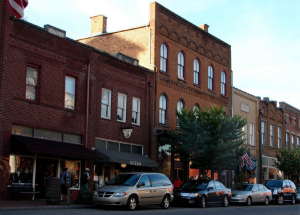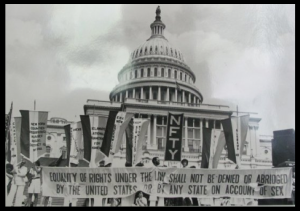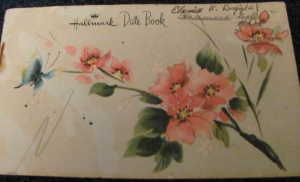All posts by Ellouise Schoettler
Glancing Over My Shoulder

These days I am wandering through my stories to select the programs I will tell next month in Jonesborough, TN. I am thrilled to be invited as Storyteller-in-Residence for the week – September 8 – 12 – at the International Storytelling Center and to tell 5 hour long programs of my work. This is also a wonderful opportunity to look through my work and think about what I have been doing with my storytelling these past thirty years.
Visual artists often stop and take stock and select works for a retrospective of their art work. Here is a chance to do the same with my story work.

When I read the Song-catcher by Sharyn McCrumb, a novel featuring a ballad handed down through generations of her southern family, I was impressed by the way she incorporates family history into her story.
I came to storytelling through genealogy and did much more of that when I first started telling stories. She inspires me to go back in that direction, asking new questions.
In the biography on her website Sharyn McCrumb talks about the two worlds of her parents. That’s true of my family too. My father’s family was proud of their social position, which was based on my grandmother’s father. He was a Mecklenburg County elected official and a very popular figure. When I looked up his obituary in the Charlotte Observer a huge picture of him stared back at me from the front page of the newspaper. My grandmother was a spoiled apple of his eye who had been schooled in a Catholic finishing school. I remember her as a tall, aristocratic looking woman who was not prone to spontaneous hugs, in fact, I don’t remember any displays of affection. The mother of eight children, she was a reader, a versifier, an Anglophile and an avid Bridge player. She was proud of her lineage, especially her Confederate roots, because she did not know her Revolutionary War ties. If she had looked into she would have found her Revolutionary War roots and saved me a lot of trouble later. She would have been proud of all those deep tap roots that came through her father’s paternal family.
Her father’s mother was an Irish immigrant, from Tipperary, Ireland who arrived in America in 1837. She came with an extended family before the potato famine. Maybe they were seeking religious freedom, because they had both money and a trade. She left us our Catholic faith. Her family arrived in America through Nova Scotia, went to Albany, New York for a time where they had family, and then came to North Carolina following the little known 1840s gold rush in North Carolina. She married a young doctor from Newton, NC and they had eight children.
Surprisingly no Irish stories have been handed down through the family. I was not raised on the stories she must have told her son and that one would think he told his daughter. And, that he might have told my father, his grandson. The newspaper articles I found about him say he was known as a storyteller and a wit.
I wish we had been left a legacy of Irish songs and stories like Sharyn McCrumb describes from her Appalachian family? Ever since I discovered my strong Irish heritage I have wondered about this.
Now, Sharyn McCrumb, in describing her family, opens the question for me from another perspective. I will dig a little deeper. I want to know why we don’t have our pockets filled with Catherine Lonergan’s stories.
A Day to Remember
July, 1978
The ERA MARCH, Washington Mall, Washington, DC
More than 100,000 women wearing white – the connection to the women who fought for the Vote – marched in favor of Congress granting an extension on the time given to pass the Equal Rights Amendment.
When the vote was taken that year theygranted an additional three years.
I was there that day marching with a group under the flag of the Coalition of Women’s Arts Organizations.
It was an exciting, energizing, and hopeful gathering on a very hot and humid Summer day in Washington. We were part of women’s history.
Those days were filled with challenges. The memories of the times and the people are vivid for me
and being a part of the 1970s Women’s Movement changed my life.
Pushing Boundaries is my personal story of those days – –
I will be telling PUSHING BOUNDARIES:
2 PM Thursday September 10 at the International Storytelling Center, Jonesborough, TN
7:30 PM Wednesday, September 16, Friendship Heights Village Com. Ctr., Chevy Chase, MD
I hope women will come to hear this story and to remember their own.
The Power of Looking Back.
Thinking about and working on The Hello Girls, the show I will present at the Capital Fringe.
A Bit About WWI Times.
Starting the day of working on my Capital Fringe Show, The Hello Girls, listening to a popular boy-girl song from WWI ERA – to get my heart, mind and imagination geared into the right time zone. Pete Wendling recorded this for the player-piano in 1917 – the country was charged with patriotic spirit as America entered the Great War, the “boys” wanted to to go “over there”, my grandmother – Louise Cobb Diggle, wrote from New York City that the air was filled with music and calls for people to buy War Bonds, but she had no idea that in 9 months her two brothers would be “over there” in France and that only one would come home. Recently I saw a small dance card from an entertainment on a troop ship on the Atlantic on the way to France – For Me and My Gal was listed on the music program. March 6, 1918 The First 33 – of the Hello Girls, left NYC behind. Proudly wearing their new dark blue Army Signal Corps uniforms they boarded a troop ship along with several thousand Doughboys and sailed to France.
Circling
A New Story – Premiere June 4
First performance JUNE 4 –
Information on June 4 Performance – Place and Time HERE
Several years ago I found this little calendar which was filled with memories. My new story, “Love Notes” began there.
From the press release:
” Love Notes”
Happily Ever After is a matter of perspective.
A 1954 blind date between an 18-year-old nursing student and a fresh faced Johns Hopkins medical student launched Ellouise and Jim on a lifetime together. Love Notes, a one–widow show performed by Ellouise Schoettler, is a funny and touching journey of a 57-year marriage traversing through the peaks and valleys of the marriage vow.
Death?
It’s not a clean break.”
Ode to Family Photos
A Nudge from the Red Tent
The Red Tent by Anita Diamant has been gathering dust on a top bookshelf downstairs for at least ten years. I started reading it once but the turned down page corner confirms that I only read to page 9. I started reading it again a few days ago. I am not sure yet whether I will finish it – – but I am underlining in the 4 page Prologue. Anita Diamant has pricked a nerve that needed a prick.
In the 1980s I was diving deeply into genealogy waters – looking for “my women” and finding things I never knew about those “survivors” who nourished my deep North Carolina tap root. I wanted to tell my family, especially my daughters, about them but only Jim listened to the stories. The others found the chorus of begats boring. Then I stumbled upon storytelling for grown-ups. I squeezed Jim’s arm one evening when we were listening to a fine storyteller tell about her father – “I am going to do that – – and they are going to come.”
That’s when I say I became a storyteller – although I was born and raised by women who were good North Carolina talkers and I learned to tell stories as they told them.
The second sentence Diamant writes for the character in the Prologue is, “my memory is dust”- meaning her story has not been told.
She goes on –
“If you want to understand any woman you must first ask about her mother and then listen carefully.
Stories about food show a strong connecton. Wistful silences demonstrate unfinished business. The more a daughter knows the details of her mother’s life – without flinching or whining – the stronger the daughter.”
There follows a page on what women and daughters share over the chores they do together and then she rocked me again.
” But the other reason women wanted daughters was to keep their memories alive.”
The character says ” I carried my mother’s stories into the next generation —-”
Then, ” I wish I had more to tell of my grandmothers. It is terrible how much has been forgotten, which is why, I suppose, remembering seems a holy thing.”
The Red Tent is a mid-rash on the life of the Biblical woman Dinah whose story is untold. Diamant’s reconstruction and re-telling is brilliant. However, I doubt I will finish reading Dinah’s fresh story. Anita Diamant has made me realize that I have a lot of work to do in a shortened time. To tell my story – and to refresh the survivors’ stories I have gathered.
I owe this to my daughters. My grand-daughters need to learn their maternal line stories first, maybe later they will have interest in mine. I don’t expect my grand-sons to have much interest at all – maybe their wives will be curious as I was about Jim’s family.
Grateful to have storytelling to use as a vehicle for sharing the stories. Perhaps,like Diamant, I will say something that will spur others to look for their stories.





No comments:
Post a Comment